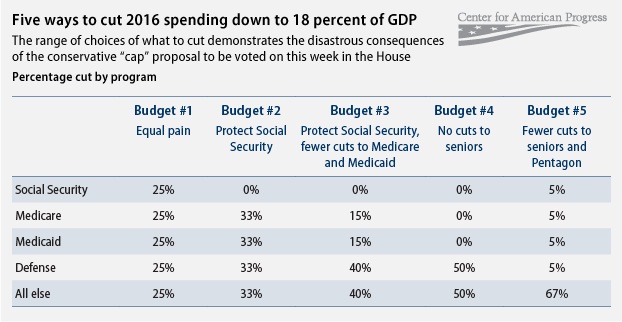By Michael Linden, Michael Ettlinger | July 18, 2011
Washington, D.C.– This week the House will vote on a proposal to cap federal spending at 18 percent of gross domestic product, the broadest measure of our economy, allowing its supporters to avoid calling for specific cuts to popular programs and avoiding the public backlash that accompanied the Republican budget passed last spring that severely cut Medicaid while slashing education, transportation, and scientific research funding. Today, the Center for American Progress released “Conservative Plan to Cap Federal Spending Is Disingenuous and Dangerous,” showing that capping federal spending at this level, not seen in half a century, would actually require cuts that are even larger than those in the original House Republican budget plan.
The last time federal spending dipped below 18 percent of GDP was 1966. Back then there were 100 million fewer people living in the United States, the median age was nearly eight years younger, and the average cost of health care was one-fifth of what it is now. In fact, no president in the last 50 years ever proposed a budget that would bring spending that low. President Reagan’s budget proposals never dropped below 21 percent of GDP, and actual spending under Reagan averaged over 22 percent. Even the budget passed by the Republican-led House, with all its draconian cuts to Medicare and Medicaid, keeps spending above 18 percent of GDP for the next 30 years.
There are different ways to bring spending to such an unrealistically low level, but Congress would need to make severe cuts to some very important programs, regardless of how the cuts are made. In the table below, Linden and Ettlinger show how federal spending could be slashed in order to meet an 18 percent cap in 2016. The first budget spreads the cuts around equally—cutting everything by 25 percent. The next three budgets protect Social Security and cut less from Medicare and Medicaid, which means they also cut far more from everything else. And the final budget shows the cuts that would be necessary if Congress wanted to protect the Pentagon as well as seniors from truly devastating cuts.

None of these options is particularly realistic. The country is simply not going to stand for massive cuts to Social Security, Medicare, and Medicaid—cuts that would fundamentally undermine the purpose and efficiency of these programs. And while we absolutely should find savings in the defense budget, few would support cuts on the order of 40 percent to 50 percent. But even if we subject those areas to smaller reductions, that would force us to cut everything else by two-thirds. Does anyone truly believe the country would be better off with two-thirds fewer food safety inspectors, two-thirds less funding for education, and two-thirds fewer dollars for the maintenance of roads and bridges?
We are a very different country than we were back in 1966, with very different needs and with stronger economic competitors making investments in their own countries to make themselves strong. We must match those investments to remain the No. 1 economy and the most competitive nation on earth. Sarah Ayres and Michael Linden’s infographic illustrate how passing the proposal to cap federal spending at 18 percent would be like putting a 1966 transmission into a 2012 Mustang.

To speak with CAP experts on this issue, please contact Laura Pereyra at [email protected] or at 202.203.8689.
###